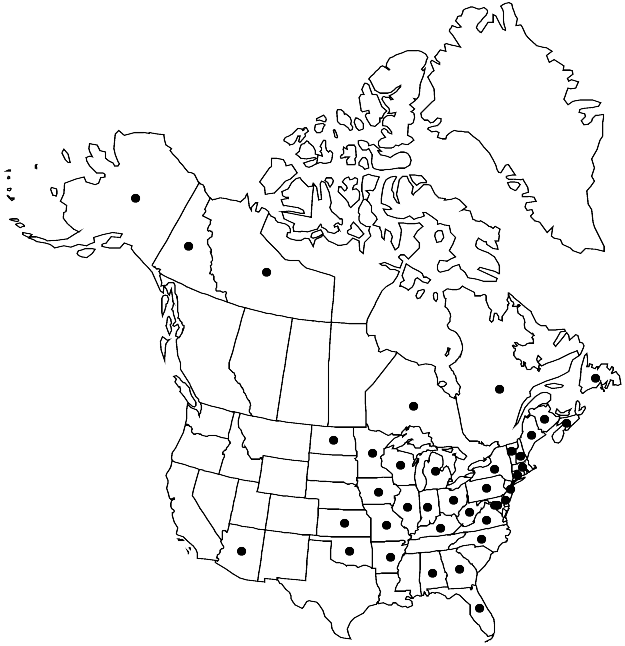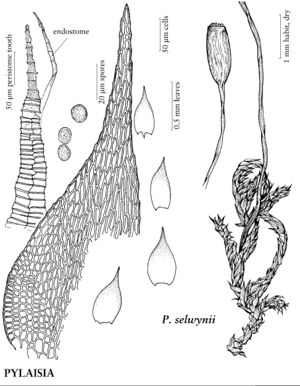Difference between revisions of "Pylaisia selwynii"
Ottawa Naturalist 2: 156. 1889.
imported>Volume Importer |
(No difference)
|
Latest revision as of 06:53, 30 July 2020
Plants yellowish to whitish. Stems terete-foliate to flattened, regularly and densely pinnate, branches 3 mm, ascending, strongly curved, subjulaceous; pseudoparaphyllia triangular, strongly dentate. Stem and branch leaves differentiated. Stem-leaves almost straight, broadly ovatelanceolate, suddenly narrowed to apex, not concave, not plicate, 0.9–1.2 × 0.5–0.6 mm; margins plane, sometimes slightly incurved distally; acumen short; costa double and short or indistinct; alar cells 20–25 along margins, in 6–10 rows; medial laminal cells 25–45 × 4–7 µm. Branch leaves oblong-lanceolate, smaller, narrower, 0.7–0.9 × 0.2–0.3 mm. Seta 1–1.5 cm. Capsule erect to suberect, oblong-ovoid, 1–1.6 × 0.6 mm; exothecial cell shape variable; operculum conic; peristome somewhat reduced; exostome teeth lanceolate, 0.1–0.2 mm, base 45–50 µm wide, finely papillose distally; endostome adherent to exostome teeth except distally, basal membrane developed except distally, segments 2-fid, split, internal surface roughly and finely papillose, segment and cilia connate. Spores 16–25 µm.
Phenology: Capsules mature fall.
Habitat: Tree trunks
Elevation: moderate to high elevations
Distribution

N.B., Nfld. and Labr. (Nfld.), N.W.T., N.S., Ont., Que., Yukon, Ala., Alaska, Ariz., Ark., Conn., Del., D.C., Fla., Ga., Ill., Ind., Iowa, Kans., Ky., Maine, Md., Mass., Mich., Minn., Mo., N.H., N.J., N.Y., N.C., N.Dak., Ohio, Okla., Pa., Vt., Va., W.Va., Wis., Mexico, Asia (sw China), Asia (Japan), Asia (Russia)
Discussion
Pylaisia selwynii is the most frequent and common species of the genus in the flora area; it is easily distinguished by the regularly and densely pinnate stems, broadly ovate-lanceolate stem leaves, comparatively numerous alar cells of the stem leaves, and adherent endostomes except for the distal portion. The stem leaves are secund and cordate.
Selected References
None.
